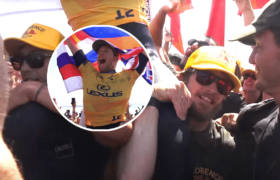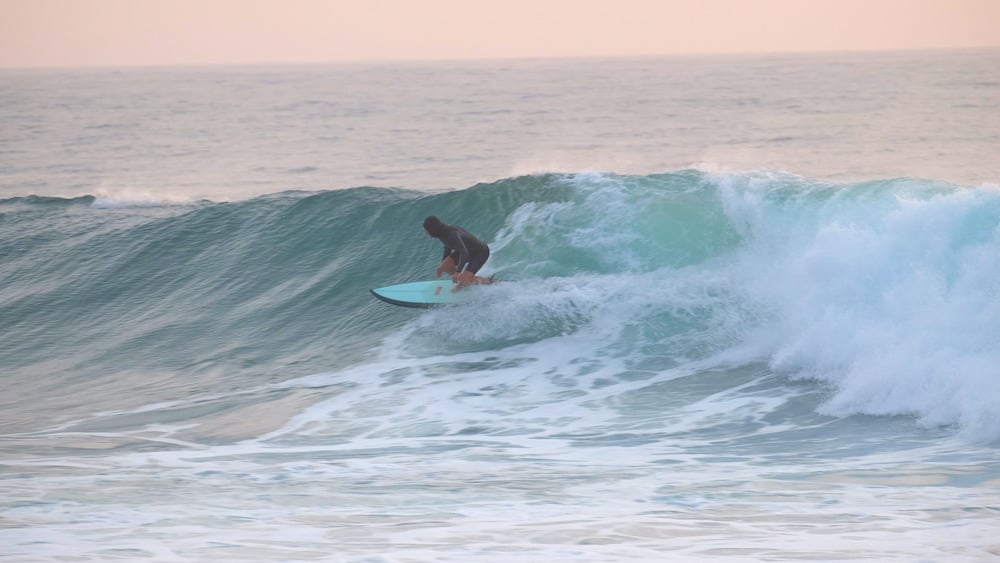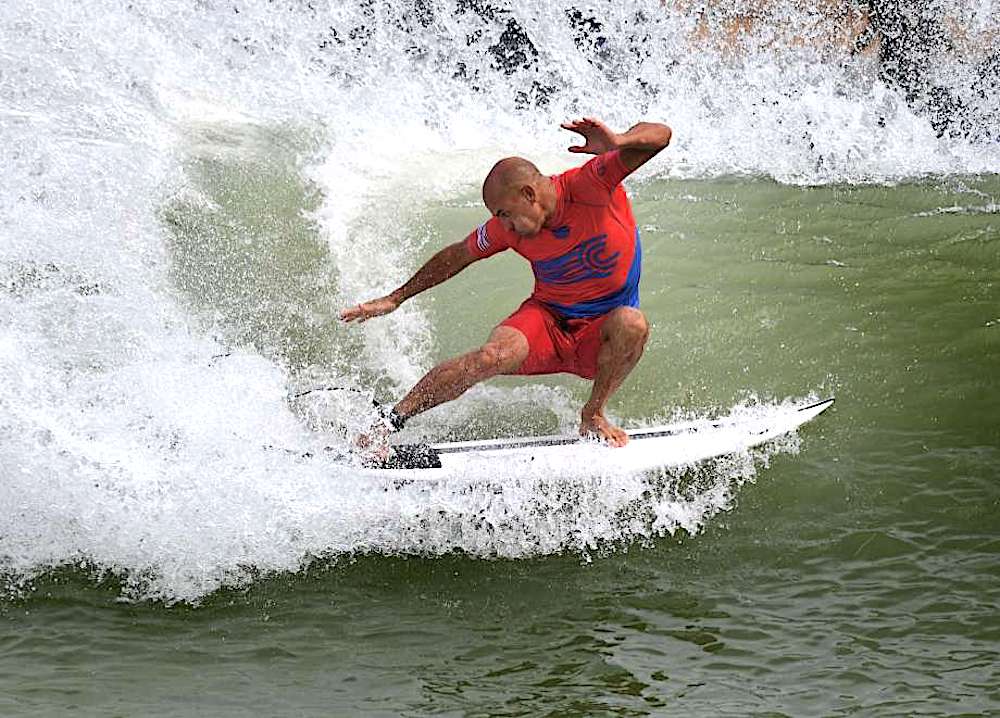More importantly, "mid-lengths won't fuck your shred…"
God, I’ve changed so much since I started writing for the Grit. Pushed out of my comfort zone so far.
Wearing Italian flat caps, getting in beefs with local enforcers and Murfer hubbies who take umbrage at what I write. Derek Rielly is always sending me provocative little ideas with a “You got this?” And seeing as I got the arse from bus driving I don’t have any choice, if I want to keep the bills paid, then to sit down and grapple with concepts that are deeply uncomfortable and will involve clear blowback.
To put out there, as the old French cock Sartre said, “Confused, vaguely questioning ideas that then fall apart.”
The old days of surf media seem so paradisiacal and sure footed by comparison: bit of advertorial, bit of hagiography, paid trip to the Tuamotus with some B-grade pros. Heaven.
I know a lot of modern surfers feel the same discomfort about mid-lengths, which is why today I bring a custom 7’3” Parmenter shaped Aleutian Juice Vector-Cuda into the classroom for show and tell. It is appropriate given Greg Webber’s 7’3” for sale and the stunning mid-length surfing laid on by Torren Martyn in Mexico, which I’m sure you have seen.
The chief argument against the mid-length is that it destroys the ability to shred on high-performance equipment. A subsidiary argument is that the mid-length identifies one as a hipster and that may not be appropriate; because either one is incapable of making the cut (too old, too fat, too ugly) or feels too much self ridicule at the potential mis-identification.
Despite these substantial concerns, the positives far outweigh the negatives.
One thing that has never changed in me is easy access to a mid-length. I can’t even remember how far back it started; finding a Mitchell Rae Outer Island seven-footer somewhere in a shed and adopting it for baby food out the front of a friend’s house on the Sunshine Coast is where it officially began, but I’m sure it goes back further.
That was before mid-lengths became fashionable and acquired a serious step up the value chain.
The old slur of mini-mal still resonates in Australia, if not elsewhere but the name change to mid-length came with a major increase in cache.
Who knows why?
As part of a continuing push back against pro surfing by a new generation who weren’t scared of being labelled pseudo-hippies or looking like victims of boomer nostalgia would be my best guess. The pay-off for the skilled becomes immediately apparent for anyone who has seen footage of Terry Fitzgerald at J-Bay: early entry, line drive, logarithmic momentum by laying trim line on trim lines.
At the other end of the scale, gliding on petite peaks or joining the dots on disconnected short-period rubbish removes the need to generate speed through monkey pumping.
The big step up the value chain is a major disincentive.
Previously, I’d surmounted the problem by acquiring a hipster board from a Byron Bay factory. Enough laps on a Friday afternoon with a six-pack of Coopers would see a second-handy in mint condition that needed to be liquidised.
A returned custom that had the wrong spray, in this case.
That resulted in a beautiful 7’1” that I passed over to my gal as a gift, and she shredded on it. A day before we were due to leave on a surfing/camping holiday I ripped a fin out rocking off at the Point and the middy was still in the car. Half-an-hour later, a freak set landed on my head and the board was in two. That was three years ago and the opportunity to replace it had not come up.
The opportunity to replace the offending husband, very much so.
Around about then or before or later, don’t cross-examine me on the timeline, there was a secondhand Parmenter Aleutian Juice in a Byron surf shop with Jeff Hakman’s name on the stringer. The Holy Bible has no injunction about coveting surfboards and I did covet it, a lot. Seven-three with an outline that was half-Hawaiian seventies shortboard and half double-ender. Pulled in nose, diamond tail. Widow maker fin set-up.
I wanted that board so bad. As a retirement plan, to put under the house and pull out when I’m 60 or my shoulder carked it or something else happened.
The following sequence of events was pure serendipity.
Parmenter was coming to Australia in Feb to hang out with Andrew Kidman and was taking shaping orders. No chance, I thought. A wonderful board builder from Oregon named Bryan Bates, who is a spitting image of Chas Smith, also from Oregon, and who now makes boards in Byron Bay, made contact with me.
I’d helped him out and now he had a deal for me. A real great deal as Jerry from Fargo would say. Dave would do the shape job and Bryan would glass the boards. Bryan has the full skill-set of resin tints, deluxe glass jobs etc etc. My last pay packet from the buses had just enough cream to cash out Bryan for the deal and wait. The board would be presented to my gal as a birthday present.
Email exchanges with Parmenter ensued.
It’s one of the great blessings of an Aleutian Juice custom. He remembered the Hakman board, put it straight into it’s historical perspective and intended usage which from my perspective was a board that could, “paddle like a barracuda and still have easy turning off the template and rocker curve, as well as the ability to lay it over off the bottom on a wind-ribbed double overhead Point wave at maximum velocity”.
For my gal I desired, “easy paddle-in, nice glide and something that turns freely and without complication and can build speed on speed if she snags an offshore set wave that runs down the sandbank”.
He named the resultant design a Vector-Cuda.
It was a great deal.
Parmenter shaped the blank and Bryan made it deluxe. The steep-angular rails were from the Brewer school, the template was tits and the widow maker fin cluster was glassed in.
For a Parmenter custom I had it in almost record time. My pal wasn’t so lucky. Shite can go pear shaped when OS shapers outsource boards to glassing houses which then get lost. His board got lost in the system and took months to get done.
A good paddler. Sometimes I wonder if people even understand the meaning of that phrase. Its transformative power. Its ability to heal the injured and comfort the elderly.
I had to patiently wait for my wife to put the first ding in it before riding it and when she ground the tip of a side-fin off on a mistimed rock off it was time.
A good paddler. Sometimes I wonder if people even understand the meaning of that phrase. Its transformative power. Its ability to heal the injured and comfort the elderly. The Vector-Cuda is glassed heavy, to last. Heavy boards follow the most basic laws of physics. Momentum = Mass times Velocity squared. Momentum joins the dots on disconnected point surf, cuts through wind, glides on little peelers. Momentum is a gal’s best friend.
I get to see a lot of insane mid-length surfing. Torryn Martyn, Joel Fitzgerald, Dave Rastovich all live in the hood and frequent the Point. Some is performative, with cameras at the ready. Seventies posing will never go out of style.
Sometimes though you’ll see Rasta at the Point on raggedy swells with no-one around. The lines he draws on a middy are pure function. A single haiku from start to finish. Completely wasted lateral surfing by CT standards.
I don’t ride it all the time. Don’t need to. Sometimes if a swell cycle is imminent it’ll get used as a deliberate strategy invented by Derek Hynd to upshift and then downshift through a quiver. You ride a 7’3” for a day or a session and then go down to a 6’0”. Your legs feel like steel springs.

I doubt Dave Parmenter would approve.
Being Catholic with board choices is a luxury for the few.
If I ended up sleeping in the dunes at J-Bay or holed up in Morocco: somewhere with lined up Points that regularly get strafed by howling offshores the Vector-Cuda would be the indispensable one board quiver. No question.
The takeaway, as Derek would ask for?
1. Mid-lengths won’t fuck your shred.
2. Good deals can turn bad but great deals can be awesome.
3. A good middy can be a reliable and trusted ally to help you negotiate the stormy vissicitudes of life.
4. You won’t find one on the rack.







